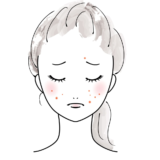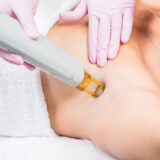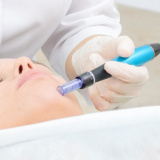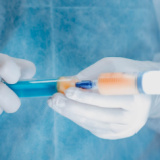Treatment of red face, telangiectasias, angiomas, and venous lakes using V-beam Norris
大阪市北区・天神橋筋六丁目(天六)駅すぐのかもがわクリニックでは、赤ら顔(顔の赤み)や毛細血管拡張症、血管腫(赤あざ)、静脈湖といったお悩みに対し、最新のVビームレーザーとIPL光治療器「ノーリス」を用いた安全で効果的な治療を行っています。ここでは両機器の特徴や仕組み、各症状への有効性、治療の安全性・副作用、必要な治療回数の目安、費用と保険適用、そして患者様のよくある質問への回答をご紹介します。
天六・天満・都島・中崎町・扇町エリアからも多数ご来院いただいています。
Features and Mechanisms of V-beam Laser and Noris (IPL)
The V-beam is a dye laser with a wavelength of 595 nm, which is selectively absorbed by hemoglobin (red pigment) in the blood, enabling the device to destroy abnormal blood vessels. The energy reaches deep into the skin and blocks unwanted capillaries by causing thermal degeneration of red blood cells in the irradiated blood vessels. It is also characterized by the fact that it has little effect on normal blood vessels and does not damage surrounding tissues. The irradiated area is protected by a cooling gas system, and the pain is limited to that of a rubber band, leaving basically no scar. On the other hand, Nordlys is a light therapy device called IPL (Intense Pulsed Light). Unlike lasers, it can emit light with a wide range of wavelengths from 500 to 1200 nm, and by adjusting the filters, it can be used for a variety of skin conditions. Since the light reacts with red hemoglobin, it can be expected to shrink redness caused by dilated capillaries. Furthermore, since it also acts on melanin pigment, it can simultaneously produce a skin beautifying effect (improvement of spots and skin texture), which is a difference from the laser.
The difference between V-beam and IPL is simply that V-beam is more powerful and effective immediately versus IPL, which is milder on the skin and requires less downtime V-beam is more effective specifically in treating vascular lesions and requires relatively fewer irradiations, but this may cause redness and internal bleeding (purpura) after treatment IPL (Noris) has mild irradiation energy and almost no downtime, but tends to require a greater number of treatments to be effective. Noris has the advantage of being able to adjust the pulse width (length of light application) in particular, enabling effective irradiation of blood vessels with extremely short pulse widths such as 1.5 milliseconds. The device itself does not require a powerful cooling function, thus reducing the burden on the skin. In fact, Nordlys is the first IPL device in Japan to obtain regulatory approval for the treatment of vascular lesions, and its safety and effectiveness have been officially recognized.
We have introduced both the V-beam laser and Norris IPL. By utilizing the advantages of each and using and combining them according to the patient's symptoms and skin type, we can provide the best treatment plan for redness concerns.
Target symptoms and treatment effects (red face, telangiectasias, angiomas, venous lakes)
V-beam acts directly on the abnormal blood vessels that cause redness and is highly effective in treating telangiectasias, red faces, acne scar redness, and red birthmarks. Noris (IPL) is also effective for redness caused by dilated blood vessels and is particularly suitable for improving slight redness of the entire skin and improving skin texture. Below is an explanation of the effectiveness of treatment with V-Beam and Noris for the main conditions that can be treated at our clinic, respectively.
Red face and rosacea
Redness (rosacea), which causes constant redness of the entire face, is a condition in which the capillaries in the skin are easily dilated and inflamed. Although it can be treated with ointments and oral medications, these alone have their limitations, and a laser or light therapy approach is more effective. Traditionally, V-beam is often used for this type of red face treatment, but because it is a powerful laser, it is very hard on sensitive rosacea skin, and some people say that their face became even more red and swollen after irradiation and that the internal bleeding did not go away easily. On the other hand, IPL (Noris) is a mild light therapy that causes less downtime and is considered a suitable treatment for Japanese rosacea, in which the redness spreads vaguely over the entire face. Overseas guidelines also position V-beam and IPL as equal options for rosacea treatment, with some recommending IPL from the standpoint of safety. At our clinic, depending on the degree of rosacea, we start treatment with IPL and add V-beam as needed to improve redness while minimizing the burden on the skin. Multiple sessions (approximately 5 to 10 sessions) are required to improve redness, but with each session, capillaries will shrink and redness will lessen.
telangiectasia
Fine vascular dilatations (so-called telangiectasias) that appear in the cheeks and nose in a reticular pattern are a symptom that does not disappear spontaneously and often remains. Since they do not go away if left untreated, it is effective to use a laser to shrink and destroy the abnormal capillaries; the V-beam laser was developed for this very purpose and can significantly reduce redness with a small number of irradiations. In fact, depending on the condition, telangiectasias often improve after one to five sessions, and in some cases, fine vessels become almost invisible after a single V-beam session. Our V-beam is a medical laser approved by the Ministry of Health, Labor and Welfare, and is covered by insurance for the treatment of telangiectasias. If a doctor diagnoses telangiectasia, the patient pays only 30% of the total cost of the treatment under the public medical insurance (children may be eligible for public subsidies under certain conditions). On the other hand, IPL irradiation with Noris is also effective for fine redness scattered over the entire skin. Because Noris can irradiate a large area at once, it can also be used to treat redness around the nose where many small blood vessels are concentrated. If you want to avoid downtime and at the same time obtain a beautiful skin effect, you can choose IPL treatment to gradually reduce redness without interfering with your daily life.
Hemangioma (red birthmark)
Congenital red birthmarks such as simple hemangiomas (so-called red birthmarks or port-wine nevi), infantile hemangiomas (strawberry hemangiomas) that appear shortly after birth, and senile hemangiomas (red mole-like tumors) associated with aging are also important indications for the V-Beam laser. The V-beam is highly effective in treating these vascular birthmarks and tumors because it reacts selectively to abnormal blood vessels. In particular, dramatic improvement of shallow hemangiomas in infants has been reported in a small number of cases due to the thinness of the skin. On the other hand, red birthmarks on the skin of adults require multiple sessions of irradiation in order to be completely removed, and the treatment is aggressive, causing purpura (internal bleeding) in the affected area after each irradiation. Even so, adult red birthmarks can be significantly reduced after about 4 to 10 sessions of irradiation, and with repeated treatments, improvement can be expected to reach a level where they are not noticeable on a daily basis. Small red mole-like lesions such as senile hemangiomas (so-called cherry angiomas) can be removed in one or two sessions of V-beam irradiation. Laser treatment of simple hemangiomas, infantile hemangiomas, and symptomatic hemangiomatosis (e.g., Sturge-Weber syndrome) is covered by insurance. In the case of insurance coverage, irradiation must be performed at specified intervals, but continuous treatment is possible at a low out-of-pocket cost.
Venous lakes (blue growths on the lips)
venous lakeis a small blue-purple hemangioma that forms mainly on the lips and is a benign mass that forms when dilated veins become stagnant with blood. There are usually no symptoms other than appearance, but biting can cause bleeding or blood clots that can be painful. Surgical excision has been the traditional treatment of choice for venous lakes, but at our clinic we offer a non-surgical laser treatment: irradiating the lesion with the V-beam laser causes the blood to coagulate within the blood vessels, causing the varicose vein to shrink and disappear over a period of several weeks. In fact, cases of complete disappearance after 6 months of a single V-beam irradiation have been reported. Laser treatment is the first choice because it does not require anesthesia and scars are barely noticeable. In the case of bulging venous lakes, scabbing and exudate may occur temporarily after irradiation, but the scabs are removed and the lakes heal beautifully in about two weeks. Larger cases may require two or three sessions of irradiation, but the advantage of this treatment is that it is less damaging and safer than incision with a scalpel.
Safety, Side Effects and Aftercare of V-Beam and Norris Therapy
Although some may be concerned about laser treatment, both the V-Beam and Norliss laser systems used at our clinic are highly safe and approved by the Ministry of Health, Labor, and Welfare. The V-Beam is administered by experienced physicians at the appropriate power setting, so there is almost no risk of serious side effects, and pain is minimized because the skin surface is protected with cooling gas during V-Beam irradiation. Even so, there are cases where the irradiated area may feel a slight stinging sensation, but we strive to reduce the burden by using a surface anesthetic cream if necessary.
The main side effect is temporary redness and swelling of the affected area after irradiation in the case of V-beam (lightening within a few hours to a few days). In addition, depending on the irradiation conditions, purpura (internal bleeding) may occur, but this is also temporary and will disappear in about 1 to 2 weeks. Especially when irradiated with high output and short pulse, such as in the treatment of red birthmarks, purpura is likely to occur, and the skin may temporarily appear brownish, but it usually settles down within 3 months. For redness treatment of the entire face, internal bleeding is less likely to occur because the irradiation is done at a lower output. Noris (IPL) is a very mild light therapy, so there is almost no downtime, with only a mild burning sensation and redness after irradiation. It is designed to be safe and easy to perform even on extremely sensitive skin.
After treatment, please refrain from prolonged bathing, strenuous exercise, and alcohol consumption on the same day, and keep the treated area clean without rubbing. In rare cases, redness may intensify the day after irradiation. In this case, cool the area gently with a cool towel and monitor the situation. If your doctor prescribes ointments, use them as directed. Also, since the skin after laser or phototherapy is easily affected by ultraviolet rays, please use sunscreen during the day to protect against ultraviolet rays. Appropriate aftercare will further reduce the risk of side effects and enhance the effectiveness of treatment.
Approximate number of treatments and duration of V-Beam Norliss
Redness treatment is not a one-time treatment, but rather a gradual improvement over several sessions. The number of required sessions varies depending on the symptoms and extent of the condition, but the following is a general guideline
- Red face and rosacea (redness of the entire face): 5 to 10 times
- telangiectasia: 1 to 5 times
- Simple hemangioma (red birthmark): Approximately 3 times for children and 4 to 10 times for adults
- Infantile hemangioma (strawberry hemangioma): Several times (depending on symptoms)
- Senile hemangioma (red mole): 1-2 times
- venous lake: 1-2 times
The basic treatment interval is about every three months for insurance, and every two to four weeks for free treatment (self-funded treatment). In the case of self-funded treatment, patients are often asked to go once a month while watching their skin recover, and in the case of insurance, the pace is a little slower in accordance with the regulations. You will notice the redness fading with each treatment, but in some cases, depending on the condition, long-term care may be required until the redness is completely erased. The doctor will schedule the irradiation at the appropriate time while monitoring the progress to maximize the effect, so please take your time and do not be in a hurry.
Cost and Insurance Coverage for V-Beam Norris
The fee depends on whether the treatment is covered by insurance or free treatment, the extent of irradiation, and the number of times the treatment is performed. If the doctor determines that the condition is "covered by insurance," such as telangiectasia, simple hemangioma, or infantile hemangioma as described above, the V-beam treatment is covered by public medical insurance, and the patient pays 30% of the cost in principle (in some cases, children are not required to pay co-payment due to local government subsidy ). On the other hand, redness improvement for rosacea and cosmetic purposes is not covered by insurance and is treated as an unrestricted medical procedure. At our clinic, after diagnosing the symptoms at the initial consultation, we will inform you whether or not insurance coverage is available and the approximate cost of the treatment. If you have any concerns, please feel free to consult us in advance.
A. The pain is mild and can be described as a rubber band being lightly popped. The V-beam has a cooling function to reduce pain, but an anesthetic cream can be applied beforehand if you are concerned.
A. With Norliss (IPL), there is almost no downtime except for a slight erythema immediately after the treatment; with V-beam, the irradiated area may be red for a few hours to a few days. Internal bleeding may occur when irradiated at high power, and it may take one to two weeks for the purple spots to disappear. However, mild irradiation of the entire face is less likely to cause internal bleeding, and most people are able to go about their daily lives with only mild redness that can be concealed with makeup.
A. It depends on the type and degree of symptoms. For example, for improvement of redness (rosacea) of the entire face, continuous treatment of around 5 to 10 times is recommended. On the other hand, in many cases, small capillary dilation and small hemangiomas can be made less noticeable after one to several sessions of irradiation. We will inform you of the approximate number of sessions at the time of the initial consultation, but it is also possible to adjust the treatment plan while monitoring the effects during the course of the treatment.
A. The doctor will make a decision based on the cause of the patient's redness and skin type, but in general, priority tends to be given to V-Beam for dark redness and large blood vessels that need intensive treatment, and Norliss for widespread, blurred redness and sensitive skin. For example, the V-Beam is a reliable approach for spot hemangiomas, while the Norliss is a mild remedy for redness of the entire face. Since we have both types of equipment, we can offer the best treatment for each individual patient.
A. Yes, there are a few precautions. Do not bathe, drink alcohol, or engage in strenuous exercise on the day of treatment. Avoid rubbing or irritating the irradiated area and keep it clean. If you feel a temporary burning sensation after the irradiation, cool it gently with a cool towel for relief. Ultraviolet rays can cause hyperpigmentation, so be sure to use sunscreen and an umbrella during the treatment period to protect against ultraviolet rays. If there are ointments or topical medications that your doctor has instructed you to use, do not forget to apply them. If you follow these instructions, you can expect a smooth recovery while preventing side effects.
If you suffer from red face or visible blood vessels, please consult our clinic for red face laser treatment in Osaka, Japan, and we will help you resolve your skin problems with the best treatment for your condition using two types of equipment: V-beam and Norris.






